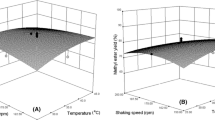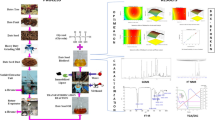Abstract
Non-edible oils represent one of the most viable alternative feed stocks for the production of large volumes of biodiesel at cheaper cost in tropical countries. The objective of the present study is to investigate the ability of the immobilized whole cells of Rhizopus oryzae MTCC 262 to catalyze the biodiesel production from karanja oil in n-hexane system. Response surface methodology was employed to evaluate the effects of synthesis parameters, such as molar ratio of oil to alcohol, reaction temperature and reaction time on percentage biodiesel (methyl esters) yield. Transesterification was performed in shake flasks containing immobilized cells in the reaction mixture with 10% oil weight of n-hexane. The quadratic effects of molar ratio of oil to alcohol and reaction time proved to be the significant at 1% and 5% levels, respectively. The optimum synthesis conditions were found to be: molar ratio of oil to alcohol 1:2.73, reaction temperature 41.39°C and reaction time 73.97 h. Biodiesel yield (methyl ester) was 75.98 (wt.%) under the optimal conditions and the subsequent verification experiments with biodiesel yield of 78.0 (wt.%) confirmed the validity of the proposed model.







Similar content being viewed by others
Abbreviations
- RSM:
-
Response surface method
- FFA:
-
Free fatty acid
- CCD:
-
Central composite design
- X i :
-
Real value
- x i :
-
Coded value
- X 0 :
-
Real value at the center point
- ΔX i :
-
Step change value
- Y :
-
Predicted response
- R 2 :
-
Coefficient of determination
- β 0 :
-
Offset term
- β i :
-
Linear effect coefficients
- β ii :
-
Squared effect coefficients
- β ij :
-
First-order interaction effect coefficients
References
Antolin G, Tinat FV, Briceno Y, Castano V, Perez C, Ramirez AI (2002) Optimization of biodiesel production by sunflower oil transesterification. Bioresour Technol 83:111–114
Ma F, Hanna MA (1999) Biodiesel production: a review. Bioresour Technol 70:1–15
Fukuda H, Kondo A, Noda H (2001) Biodiesel fuel production by transesterification of oils. J Biosci Bioeng 92(5):405–416
Mamoru ISO, Baoxue C, Masashi E (2001) Production of biodiesel fuel from triglycerides and alcohol using Immobilized lipase. J Mol Catal B: Enzym 16:53–58
Oznur K, Melek T (2002) Immobilized Candida antarctica lipase catalyzed alcoholysis of cotton seed oil in a solvent free medium. Bioresour Technol 83:125–129
Kaieda M, Samukawa T, Kondo A, Fukuda H (2000) Effect of methanol and water contents on production of biodiesel fuel from plant oil catalyzed by various lipases in a solvent-free system. J Biosci Bioeng 9:12–15
Matsumoto T, Takahashi SA, Kaieda M, Leds M, Tanaka A, Fukuda H (2001) Yeast whole-cell biocatalyst constructed by intracellular overproduction of Rhizopus oryzae lipase applicable to biodiesel fuel production. Appl Microbiol Biotechnol 57:515–520
Ban K, Kaieda M, Matsumoto T, Kondo A, Fukuda H (2001) Whole-cell biocatalyst for biodiesel fuel production utilizing Rhizopus oryzae cells immobilized within biomass support particles. Biochem Eng J 8:39–43
Ramos LP, Wilhelm HM (2005) Current status of biodiesel development in Brazil. Appl Biochem Biotechnol 123:807–819
Sharma YC, Singh B (2008) Development of biodiesel from karanja, a tree found in rural India. Fuel 87:1740–1742
Malaya N, Meher LC, Naik SN, Das LM (2008) Production of biodiesel from high free fatty acid karanja (Pongamia pinnata) oil. Biomass Bioenergy 32:354–357
Kaieda M, Samukawa T, Matsumato T, Ban K, Kondo A, Shimada Y, Noda H, Nomoto F, Ohtsuka K, Izumoto E, Fukuda H (1999) Biodiesel fuel production from plant oil catalyzed by R. oryzae lipase in a water containing system without an organic solvent. J Biosci Bioeng 88:627–631
Soumanou MM, Bornscheuer UT (2003) Improvement in lipase catalyzed synthesis of fatty acid methyl esters from sunflower oil. Enzyme Microb Technol 33:97–103
Myers RH, Montgomery DC (1995) Response surface methodology: process and product optimization using designed experiments. Wiley, Canada, pp 54–96
Aravindan R, Viruthagiri T (2007) Optimization of medium composition for lipase production by Candida rugosa NCIM 3462 using response surface methodology. Can J Microbiol 53(5):643–655
Uosukainen E, Lamsa M, Linko YY, Linko P, Leisola M (1999) Optimization of enzymatic transesterification of rapeseed oil ester using response surface and principal component methodology. Enzyme Microb Technol 25:236–243
Chang HM, Liao HF, Lee CC, Shieh CJ (2005) Optimized synthesis of lipase catalyzed biodiesel by Novozym 435. J Chem Technol Biotechnol 80:307–312
Chen X, Du W, Liu D, Ding F (2008) Lipase-mediated methanolysis of soybean oils for biodiesel production. J Chem Technol Biotechnol 83:71–76
Vincente G, Martinez M, Aracil J (2004) Integrated biodiesel production: a comparison of different homogeneous catalysts systems. Bioresour Technol 92:297–305
Domingos AK, Saad EB, Wilhelm HM, Ramos LP (2008) Optimization of the ethanolysis of Raphanus sativus (L. var.) crude oil applying the response surface methodology. Bioresour Technol 99:1837–1845
Ban K, Hama S, Nishizuka K, Kaieda M, Matsumoto T, Kondo A, Noda H, Fukuda H (2002) Repeated use of whole cell biocatalysts immobilized within biomass support particles for biodiesel fuel production. J Mol Catal B: Enzym 17:157–165
Yuan X, Liu J, Zeng G, Shi J, Tong J, Huang G (2008) Optimization of conversion of waste rapeseed oil with high FFA to biodiesel using response surface methodology. Renew Energy 33(7):1678–1684
Nie K, Xie F, Wang F, Tan T (2006) Lipase catalyzed methanolysis to produce biodiesel: optimization of the biodiesel production. J Mol Catal B: Enzym 43:142–147
Shieh CJ, Liao HF, Lee CC (2003) Optimization of lipase catalyzed biodiesel by response surface methodology. Bioresour Technol 88:103–106
Tamalampudi S, Talukder MR, Hama S, Numata T, Kondo A, Fukuda H (2008) Enzymatic production of biodiesel from Jatropha oil: a comparative study of immobilized-whole cell and commercial lipases as a biocatalyst. Biochem Eng J 39:185–189
Acknowledgments
The authors gratefully acknowledge the Chemical Engineering Department, Annamalai University for providing the facilities to carry out the research work. The financial support from the Tamil Nadu State Council for Science and Technology, Tamil Nadu through Science and Technology scheme for this research work is also acknowledged with thanks.
Author information
Authors and Affiliations
Corresponding author
Rights and permissions
About this article
Cite this article
Ganesan, D., Rajendran, A. & Thangavelu, V. Response surface optimization for the transesterification of karanja oil using immobilized whole cells of Rhizopus oryzae in n-hexane system. Biomass Conv. Bioref. 2, 11–20 (2012). https://doi.org/10.1007/s13399-011-0029-8
Received:
Revised:
Accepted:
Published:
Issue Date:
DOI: https://doi.org/10.1007/s13399-011-0029-8




